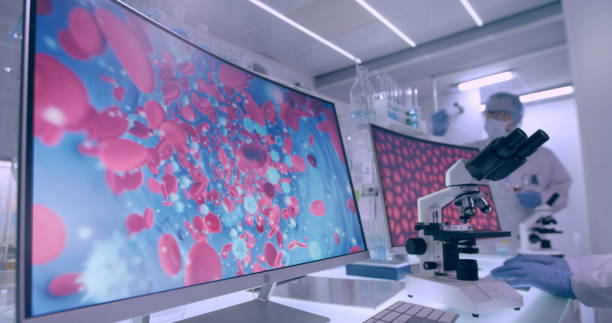The Role of AI in Pathology: Enhancements and Innovations in 2024

The Role of AI in Pathology: Enhancements and Innovations in 2024
Introduction In 2024, Artificial Intelligence (AI) continues to redefine the field of pathology by introducing significant enhancements and innovations. These advancements are streamlining diagnostic processes and increasing the accuracy of pathological assessments, which are integral to effective disease management and treatment planning.
Transforming Pathology with AI AI technologies, particularly in machine learning and image analysis, are becoming indispensable tools in pathology. They assist pathologists in analyzing samples more quickly and with greater precision, leading to faster and more reliable diagnoses.
Benefits of AI in Pathology
- Increased Diagnostic Accuracy: AI algorithms can detect subtle patterns in tissue samples that may be overlooked by the human eye. This capability enhances the accuracy of diagnoses for conditions such as cancer.
- Efficiency in Sample Processing: AI can rapidly analyze large volumes of samples, reducing turnaround times and allowing pathologists to focus on more complex cases.
- Standardization of Diagnoses: AI helps standardize diagnostic criteria across different laboratories, reducing variability and improving the consistency of patient care.
Implementing AI in Pathology Departments For healthcare facilities looking to integrate AI into their pathology departments, the following steps can be considered:
- Invest in Quality AI Systems: Choose AI solutions that are proven to be effective and are tailored to meet the specific needs of pathology.
- Training and Development: Ensure that pathologists and laboratory technicians are trained in the use of AI tools, including understanding their capabilities and limitations.
- Ethical and Regulatory Compliance: Adhere to ethical standards and regulatory requirements related to the use of AI in medical diagnostics to protect patient privacy and data integrity.
Challenges in Integrating AI While AI offers numerous advantages, integrating it into pathology practice presents several challenges:
- Technological Adaptation: Adapting current systems to integrate AI technology can require significant technological updates and investment.
- Reliability Concerns: Ensuring the reliability of AI systems and addressing any errors that could impact patient outcomes.
- Interpreting AI Decisions: Understanding and interpreting the rationale behind AI-driven diagnoses is necessary to maintain trust and accuracy.
Conclusion AI is reshaping the landscape of pathology by enhancing diagnostic accuracy, efficiency, and consistency. As we continue through 2024, the adoption of AI in pathology is setting new standards for how diseases are diagnosed and managed, impacting patient care significantly.
Call to Action Healthcare institutions should embrace the potential of AI to transform pathology by investing in advanced AI technologies and training their staff to use these tools effectively. This proactive approach will not only enhance diagnostic services but also improve overall patient outcomes.
In 2024, Artificial Intelligence (AI) continues to redefine the field of pathology by introducing significant enhancements and innovations. These advancements are streamlining diagnostic processes and increasing the accuracy of pathological assessments, which are integral to effective disease management and treatment planning.
**Transforming Pathology with AI**
AI technologies, particularly in machine learning and image analysis, are becoming indispensable tools in pathology. They assist pathologists in analyzing samples more quickly and with greater precision, leading to faster and more reliable diagnoses.
**Benefits of AI in Pathology**
1. **Increased Diagnostic Accuracy:** AI algorithms can detect subtle patterns in tissue samples that may be overlooked by the human eye. This capability enhances the accuracy of diagnoses for conditions such as cancer.
2. **Efficiency in Sample Processing:** AI can rapidly analyze large volumes of samples, reducing turnaround times and allowing pathologists to focus on more complex cases.
3. **Standardization of Diagnoses:** AI helps standardize diagnostic criteria across different laboratories, reducing variability and improving the consistency of patient care.
**Implementing AI in Pathology Departments**
For healthcare facilities looking to integrate AI into their pathology departments, the following steps can be considered:
– **Invest in Quality AI Systems:** Choose AI solutions that are proven to be effective and are tailored to meet the specific needs of pathology.
– **Training and Development:** Ensure that pathologists and laboratory technicians are trained in the use of AI tools, including understanding their capabilities and limitations.
– **Ethical and Regulatory Compliance:** Adhere to ethical standards and regulatory requirements related to the use of AI in medical diagnostics to protect patient privacy and data integrity.
**Challenges in Integrating AI**
While AI offers numerous advantages, integrating it into pathology practice presents several challenges:
– **Technological Adaptation:** Adapting current systems to integrate AI technology can require significant technological updates and investment.
– **Reliability Concerns:** Ensuring the reliability of AI systems and addressing any errors that could impact patient outcomes.
– **Interpreting AI Decisions:** Understanding and interpreting the rationale behind AI-driven diagnoses is necessary to maintain trust and accuracy.
**Conclusion**
AI is reshaping the landscape of pathology by enhancing diagnostic accuracy, efficiency, and consistency. As we continue through 2024, the adoption of AI in pathology is setting new standards for how diseases are diagnosed and managed, impacting patient care significantly.
**Call to Action**
Healthcare institutions should embrace the potential of AI to transform pathology by investing in advanced AI technologies and training their staff to use these tools effectively. This proactive approach will not only enhance diagnostic services but also improve overall patient outcomes.



